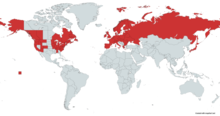Merodon equestris
| Merodon equestris | |
|---|---|

| |
| Grooming | |
| Scientific classification | |
| Domain: | Eukaryota |
| Kingdom: | Animalia |
| Phylum: | Arthropoda |
| Class: | Insecta |
| Order: | Diptera |
| Family: | Syrphidae |
| Genus: | Merodon |
| Species: | M. equestris
|
| Binomial name | |
| Merodon equestris (Fabricius, 1794)
| |

| |
| Distribution map | |
| Synonyms | |
Merodon equestris (Narcissus bulb fly, greater bulb fly, large bulb fly, large Narcissus fly) [6][7][8] Like many other hoverflies it displays a colouration pattern similar to a stinging insect (a
Description
A stout fly with a small head (10-14 mm in length).[9] The tergites are black, without the dust spots or blue-purple sheen of other Merodon species. The thorax and abdomen are hidden by dense, long, erect hairs of variable colouration. Tibia 3 of the male has 2 spurs at the apex.[10] The larva is described and figured by Hodson (1932) [11] and it is illustrated in colour by Rotheray (1993).[12]
Distribution
In the
Biology
They inhabit open areas in deciduous forest up into the subalpine zone but significantly synanthropic, occurring in suburban parks and gardens and on horticultural land.[13] The adult flies low in April to July with a fast zig-zag flight, among ground vegetation frequently settling on bare ground. Adult M. equestris feed on pollen and nectar. They visit a large variety of flowers for nectar,[14] while the larvae feed internally in tissues of bulbs of Amaryllidaceae, and they are regarded as a horticultural pest, especially of Narcissus. Females lay 1 egg at a time on leaves of this plant (or in soil by it). Larvae overwinter in the bulbs.[9] A bibliography of the literature on the biology of M. equestris is given by Barkemeyer (1994).[15]
Colour forms
-
var. equestris (female)
-
var. narcissi (male)
-
var. validus (female)
References
- doi:10.2305/IUCN.UK.2021-3.RLTS.T149168430A149168435.en. Retrieved 21 October 2022.)
{{cite journal}}: CS1 maint: date and year (link - ^ "Hoverflies". Retrieved 2009-12-12.
- ^ Stubbs, Alan E. & Falk, Steven J. (1983). British Hoverflies: An Illustrated Identification Guide. British Entomological & Natural History Society. pp. 253, xvpp.
- ^ Van Veen, M. (2004) Hoverflies of Northwest Europe: identification keys to the Syrphidae. 256pp. KNNV Publishing, Utrecht.addendum
- ^ Van der Goot,V.S. (1981) De zweefvliegen van Noordwest - Europa en Europees Rusland, in het bijzonder van de Benelux. KNNV, Uitgave no.32: 275pp. Amsterdam.
- ISBN 81-205-0080-6.
- ^ Coe, R.L. (1953) Diptera: Syrphidae. Handbks.ident.Br.insects, 10(1): 1-98. R.ent.Soc.London. pdf
- ^ Peck, L.V. (1988) Syrphidae. In: Soos, A. & Papp, L. (eds.) Catalogue of Palaearctic Diptera, 8: 11-230. Akad.Kiado, Budapest.
- ^ ISBN 978 1 4027 4153 1.
- ^ Bradescu, V. (1991) Les Syrphides de Roumanie (Diptera, Syrphidae), Clés de détermination et répartition. Trav.Mus.Hist. nat. Grigore Antipa, 31: 7-83.
- ^ Hodson, W.E.H. (1932) The large narcissus fly, Merodon equestris, Fab. (Syrphidae). Bull.Ent.Res., 23: 429-448
- ^ Rotheray G., 1993 Colour Guide to Hoverfly Larvae Diptera, Syrphidae in Britain and Europe Dipterists Forum pdf
- ^ a b Speight, M.C.D. (2011). "Species accounts of European Syrphidae (Diptera)" (PDF). Syrph the Net, the Database of European Syrphidae. 65: 285pp.
- ^ de Buck, N. (1990) Bloembezoek en bestuivingsecologie van Zweefvliegen (Diptera, Syrphidae) in het bijzonder voor elgië. Doc.Trav. IRSNB, no.60, 1-167.
- ^ Barkemeyer, W. (1994) Untersuchung zum Vorkommen der Schwebfliegen in Niedersachsen und Bremen (Diptera: Syrphidae). Naturschutz und Landschaftspflege in Niedersachsen, 31: 1-514.
External links
![]() Media related to Merodon equestris at Wikimedia Commons
Media related to Merodon equestris at Wikimedia Commons




